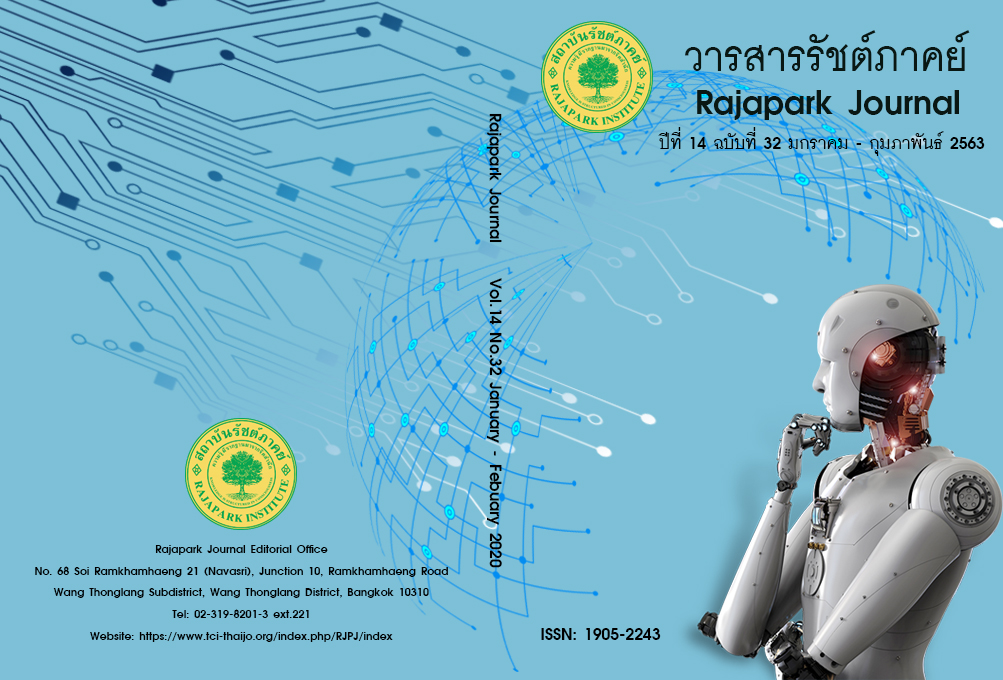Risk, Return and Performance of Equity Funds in Thailand
Main Article Content
Abstract
The research aims to examine the risk, return, and performance of equity funds in Thailand. The study period was 5 years from 01 January 2013 to 31 December 2017. The results indicated that the equity fund exhibited an average 5 years. Risk measured by standard deviation was 14.45%, which was higher than the Stock Exchange of Thailand (SET), exhibiting of 12.19%. Risk measured by beta was on average of 0.77, which was lower than the Stock Exchange of Thailand (SET) exhibiting of 1. The dividend-adjustedet Asset Value (NAV) return was on average of 14.45%, which was higher than the Stock Exchange of Thailand (SET) exhibiting of 5.5%. These showed that equity funds outperformed the Stock Exchange of Thailand (SET) in terms of higher returns with lower risk measured by beta. Performance measured by the Sharpe ratio, Treynor ratio, Jensen’s alpha, and Information ratio showed an average f 0.05, 17.47, 5.47, and 3.41, respectively. Both Sharpe and Treynor ratios areperformed the Stock Exchange of Thailand, showing 0.37 and 4.50, respectively. Such outperformance confirms that equity fund is a good alternative for investment.
Article Details
Views and opinions appearing in the Journal it is the responsibility of the author of the article, and does not constitute the view and responsibility of the editorial team.
References
Adhav, Sunil M., & Chauhan, Dr. Pratap M. (2015). “Comparative Study of Mutual Funds of Selected Indian
Companies”. International Journal of Science, Technology & Management, 4(2), 44-51.
Arditti, Fred D. (1971). “Another Look at Mutual Fund Performance”. The Journal of Financial and Quantitative
Analysis, 6(3), 909-912.
Arugaslan, Onur., Edwards, Ed., & Samant, Ajay. (2007). “Evaluating large US-based equity mutual funds
using risk-adjusted performance measures”. International Journal of Commerce and Management,
(1/2), 6-24.
Aggarwal, Rajesh K., & Jorion, Philippe. (2010). “The performance of emerging hedge funds and managers”.
Journal of Financial Economics, Elsevier, 96(2), 238-256.
Boudreaux, Denis O. et al. (2007). “Empirical Analysis of International Mutual Fund Performance”. International
Business & Economics Research Journal, 6(5), 19-22.
Carlson, Robert S. (1970). “Aggregate Performance of Mutual Funds”. The Journal of Financial and Quantitative
Analysis, 5(1), 1-32.
Grinblatt, Mark., & Titman, Sheridan. (1992). “The Persistence of Mutual Fund Performance”. The Journal of
Finance, 47(5), 1977-1984.
ICI Investment Company Institute. (2019). Investment Company Fact Book. Retrieved July 1, 2019, from:
https://www.icifactbook.org/ch3/18_fb_ch3,
Jensen, Michael C. (1968). “The Performance of Mutual Funds in the Period 1945-1964”. The Journal of
Finance, 23(2), 1-36.
Kesavraj, Dr. Geeta. (2013). “A Study on Customer Perception Towards Various Types of Mutual Funds in
Chennai”. Asia Pacific Journal of Research, 1(10), 17-26.
Ippolito, Richard A. (1989). “Efficiency with Costly Information: A Study of Mutual Fund Performance, 1965-
”. The Quarterly Journal of Economics, 104(1), pp. 1-23.
Malkiel, Burton G. (1995). “Returns from investing in equity mutual funds 1971 to 1991”. The Journal of Finance,
(2), 549–572.
McDonald, John G. (1974). “Objectives and Performance of Mutual Funds 1960-1969”. The Journal of Financial
and Quantitative Analysis, 9(3), 311-333.
Miller, Tom W., & Gressis, Nicholas. (1980). “Nonstationarity and Evaluation of Mutual Fund Performance”. The
Journal of Financial and Quantitative Analysis, 15(3), 639 -654.
Noulas, Athanasios G., Papanastasiou, John A., & Lazaridis, John. (2005). “Performance of Mutual Funds”.
Managerial Finance, 31(2), 101-112.
Otten, Roger., & Bams, Dennis. (2002). “European Mutual Fund Performance”. European Financial
Management, 8(1), 75-101.
Redman, Arnold L., Gullet, N. S., & Manakyan, Herman. (2000). “The Performance of Global and International
Mutual Funds”. The Journal of Financial and Strategic Decisions, 13(1), 75-85.
Roy, Subrata., & Ghosh, Shantanu K. (2012). “A Comparative Study of Mutual Fund Performance during
Recession in India”. International Journal of Financial Management, 2(2), 53-64.
SEC. (2017). “The Securities and Exchange Commission, Thailand”. Retrieved July 1, 2019, from
Sharpe, William F. (1966). “Mutual Fund Performance”. The Journal of Business, 39(1), 119-138.
ThaiBMA. (n.p.). “The Thai Bond Market Association”. Retrieved July 1, 2019, from: http://www.thaibma.or.th/
Thai mutual fund. (n.p.) “About Mutual Fund”. Retrieved July 1, 2019, from: https://www.thaimutualfund.com
/AIMC/aimc_about.jsp


